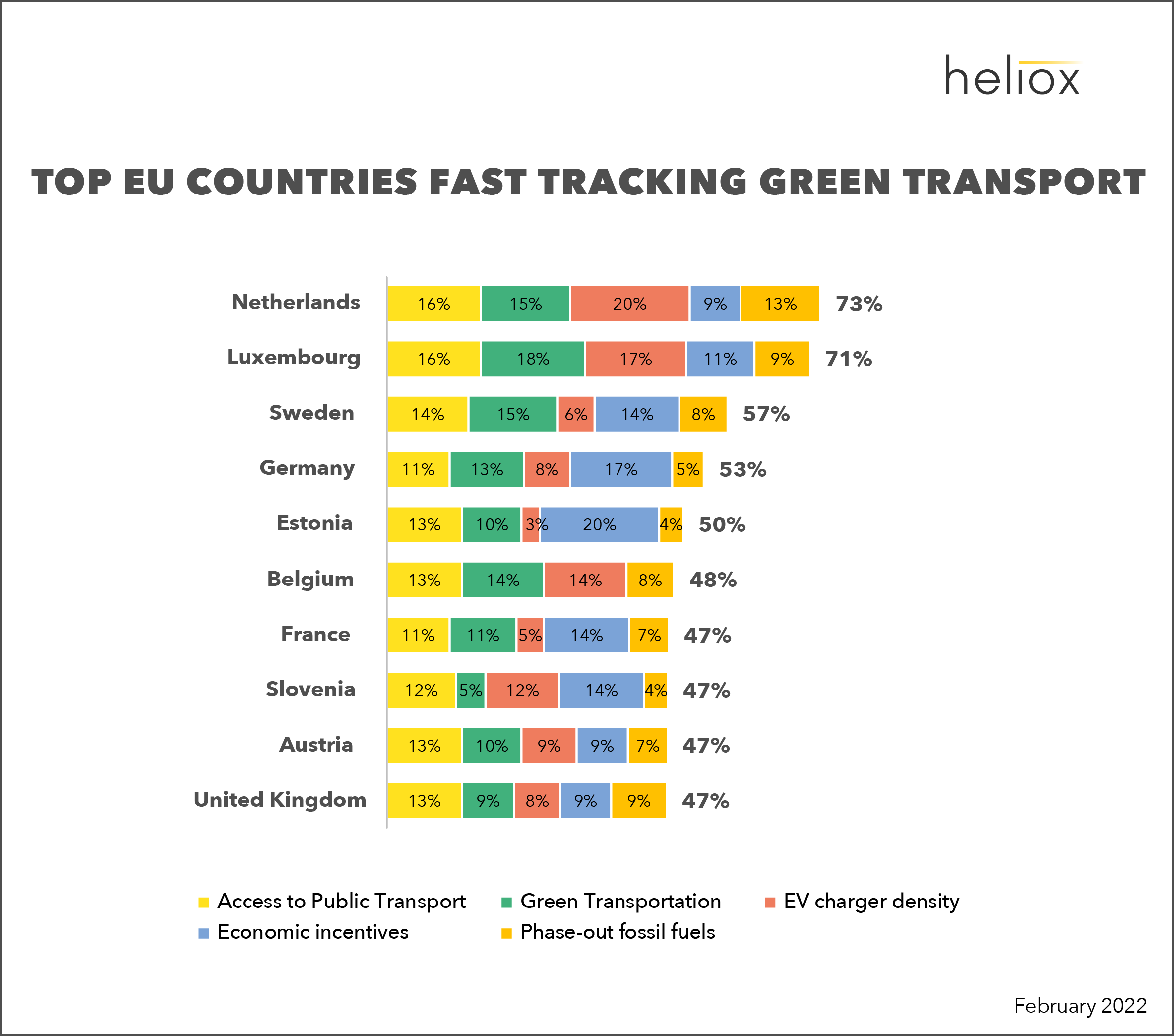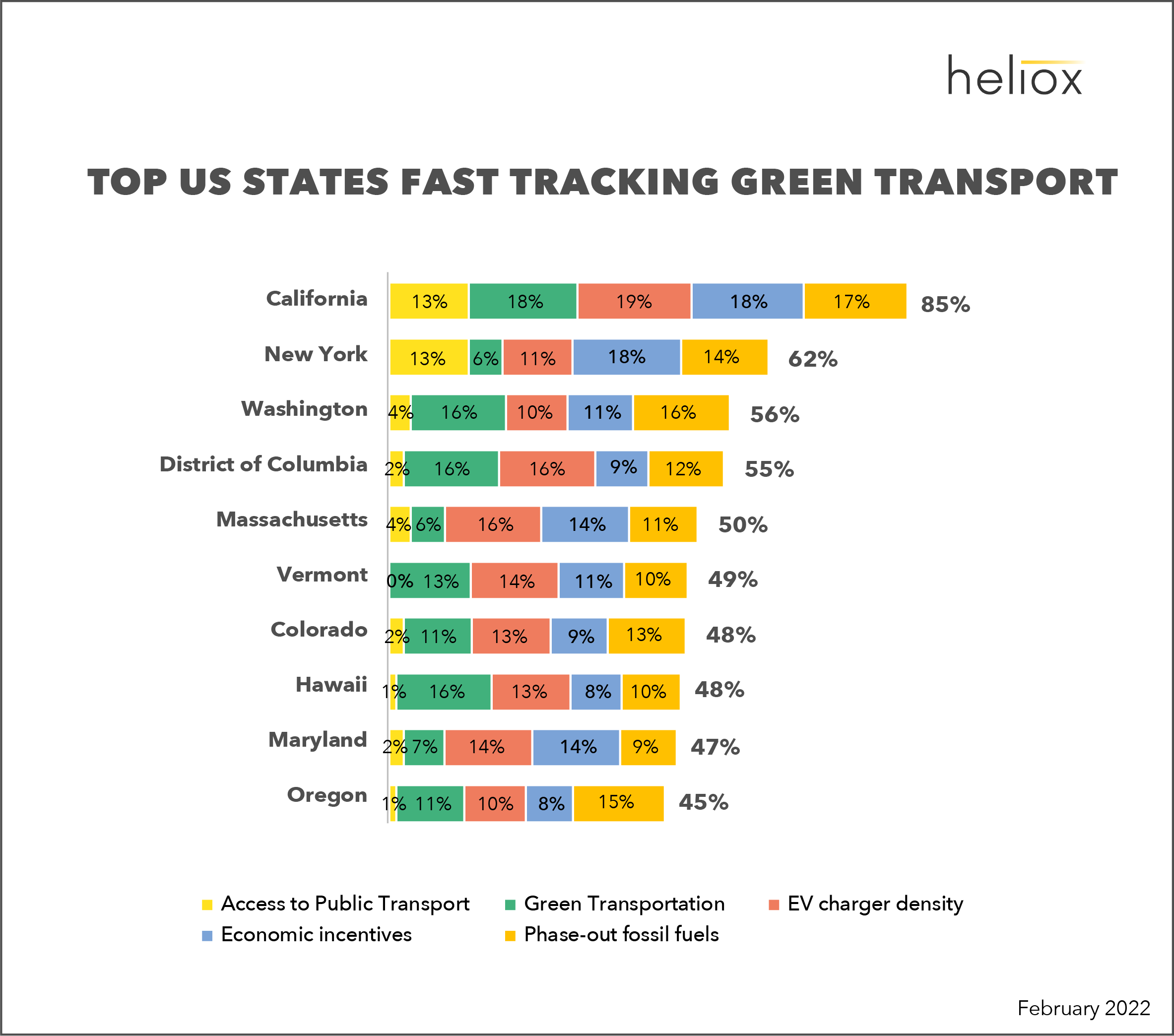What are European nations and US states doing in terms of green transport to become more sustainable for their citizens and the planet?
Data on European countries Net Zero aspirations shows the Netherlands is leading the charge with its access to EV chargers and its plans to phase out fossil fuels.
The infrastructure investment has accelerated the ambitious net zero plans in the US, where access to EV chargers and green public transportation make California champion.
The recent adoption of green transport in some countries is indicative of the shift to more environmentally friendly practices taking place around the world. While not all aspects of this shift may be known, there are places that are making headway into green transport.
But what measures are governments and leaders taking to curb carbon emission and improve transportation? Which country or state is doing the most? In this article you will find out how Europe's top countries and U.S. states rank in comparison.
Heliox has conducted research evaluating EU countries and US states across a series of criteria to measure intent and actions towards this green transport transition, and now releases the rankings of the most advanced countries in Europe and states in the US when it comes to achieving green transport goals.
The piece will review the top 10 for each region, highlighting each major country and state, and evaluating them using a combination of criteria including: access to public transportation; availability of green public transportation; public EV charging stations; green passenger vehicle incentives; zero emission goals; and phase out and net zero.
Smaller countries rank top for navigating the green transport challenges in Europe

From an overall evaluation, European countries are committed to meeting their sustainable goals by expanding green vehicles and reducing carbon emissions. The analysis found that the Netherlands, Sweden, Belgium, Luxembourg, and Denmark rank higher are the most advanced countries in terms of green transportation initiatives and infrastructure. These European countries expressed their commitment by improving access to public transportation and promoting the use of green passenger car vehicles, and short-term net zero goals. The United Kingdom, Estonia, France, Lithuania, and Austria rounded out the Top 10 list.
Providing insight into the findings, Michael Colijn, CEO of Heliox, “though operating in different manners these countries are leading the charge with their multifaceted approach, bringing them a step closer to a zero-emission future. So much so that they’re leaving a blueprint for every country to follow suit in their decarbonization journey”.
Despite larger nations such as the UK, France and Germany planning to invest a total of €200 billion to meet net zero goals, smaller countries such as Luxembourg and Sweden rank above them. The Netherlands, which has the greatest EV charger infrastructure with more than 90.000 charger locations, has outlined an ambitious goal to become carbon neutral by 2050 and for 100% of vehicle sales to be zero-emission vehicles by 2030.
Because Sweden, Luxembourg and Estonia have small populations we can expect them to have a larger density of EV chargers. However, except for Luxembourg, their economic incentives to promote green transport are what is boosting their overall position. Estonia was ranked the most favorably for economic incentives for private EVs, offering their citizens up to €18K which is limited to a maximum of 50 percent of the vehicle price, whilst the UK and the Netherlands ranked 19th and 20th.
California, New York, and Washington: the most committed states to green transportation initiatives and infrastructure

The infrastructure investments have accelerated the already ambitious net zero plans of the top ten states on our list by making billions of dollars available to replace thousands of transit vehicles, including buses, with clean, zero emission vehicles. When combined with EV passenger vehicle infrastructure and subsidies and ambitious net zero goals, five states rose above the rest. The analysis finds that California, New York, Washington, District of Columbia, and Massachusetts are the most committed to green transportation initiatives and infrastructure. Rounding out the Top 10 list are Vermont, Colorado, Hawaii, Maryland, and Oregon.
“These states are leading the way–and providing a blueprint for other states–in their multifaceted approach to cutting carbon and envisioning a zero emissions future,” said David Aspinwall, president of Heliox in North America.
California demonstrated a commitment to both greening their public transportation and promoting the use of green passenger vehicles through economic incentives, charger availability, and net zero goals. Los Angeles, like the Netherlands in Europe, has outlined an ambitious goal to become carbon neutral, and for 100% of vehicle sales to be zero-emission, by 2030.
New York’s promotion of public transport, and its support of electric passenger vehicles with a commitment to install 50,000 chargers by 2030, have made the state another emerging leader in green transportation. Washington State’s generous sales tax exemption for the purchase of new or used clean alternative fuel passenger vehicles and its zero emission vehicle grants are helping catalyze the shift to electric transportation across the Pacific Northwest. Massachusetts also makes the top five as the state with the second highest EV charging density (1:1500 ports/residents), as well as being top three in EV incentive funding both the purchase of electric vehicles and EV charging infrastructure.
Promoting green transport for a greener world
Creating a world where environmental pollution is minimized, eliminated, guarded against. Hopefully, as countries invest in being more sustainable and preserving the environment, the future of green transport presents many options to reduce our carbon footprint without requiring substantial changes to our lifestyles. Imagine a world where it will soon be possible for everyone to commute one way or the other without the process being too hurtful for our planet. That sounds like a world worth living in - and it is totally feasible and accessible, as we can already see.

